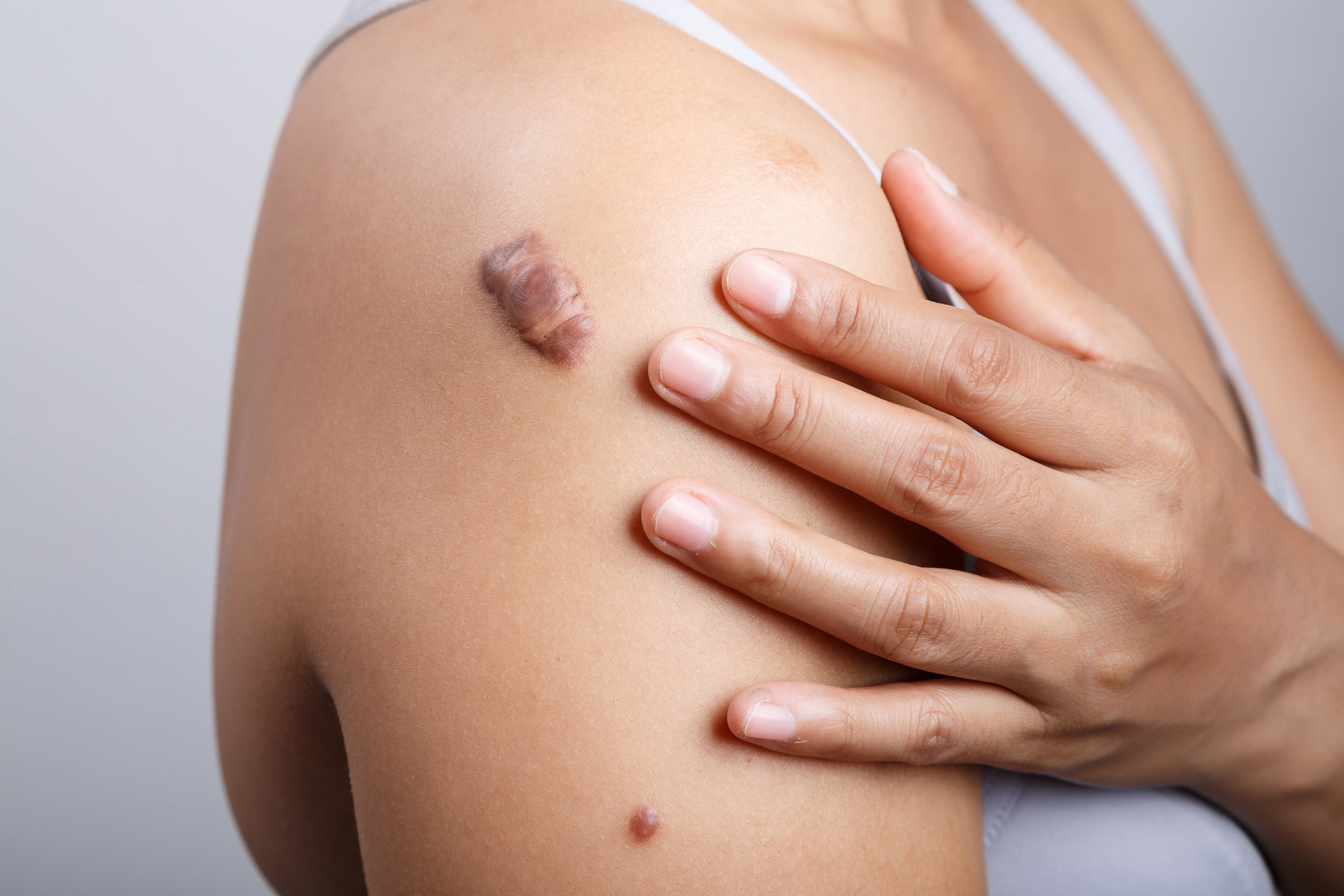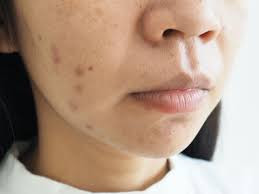Definition
The skin is a vital component of the human body, serving to shield us from physical, chemical, and biological hazards. Well-maintained skin also enhances one’s appearance. Broadly, the skin consists of three layers: the outermost epidermis, the middle dermis, and the innermost hypodermis.
Human skin can undergo inflammation due to various factors such as infections and injuries. Damage to the skin layers following inflammation can lead to scarring. One common form of scarring is post-inflammatory hyperpigmentation, where the skin becomes darker than the surrounding area.
Terminologically, post-inflammatory hyperpigmentation is defined as a skin disorder occurring after inflammation or injury. It is prevalent across all demographics but is more frequently observed in individuals with pigmented skin, including Indonesians.
The darker the skin, the higher the intensity and persistence of post-inflammatory hyperpigmentation. Individuals with darker skin and acne are 65% more likely to experience this condition.
Generally, this condition can improve spontaneously, a process that may take months to years, necessitating long-term care. Post-inflammatory hyperpigmentation often has a significant psychological impact, particularly when it affects visible areas like the face and hands.
Causes
The skin is a vital component of the human body, serving to shield us from physical, chemical, and biological hazards. Well-maintained skin also enhances one’s appearance. Broadly, the skin consists of three layers: the outermost epidermis, the middle dermis, and the innermost hypodermis.
Human skin can undergo inflammation due to various factors such as infections and injuries. Damage to the skin layers following inflammation can lead to scarring. One common form of scarring is post-inflammatory hyperpigmentation, where the skin becomes darker than the surrounding area.
Terminologically, post-inflammatory hyperpigmentation is defined as a skin disorder occurring after inflammation or injury. It is prevalent across all demographics but is more frequently observed in individuals with pigmented skin, including Indonesians.
The darker the skin, the higher the intensity and persistence of post-inflammatory hyperpigmentation. Individuals with darker skin and acne are 65% more likely to experience this condition.
Generally, this condition can improve spontaneously, a process that may take months to years, necessitating long-term care. Post-inflammatory hyperpigmentation often has a significant psychological impact, particularly when it affects visible areas like the face and hands.
Risk factor
Post-inflammatory hyperpigmentation can affect individuals of all ages and genders. However, certain factors increase the risk, including:
- Pigmented skin,
- Dark skin with acne.
Symptoms
Post-inflammatory hyperpigmentation is generally asymptomatic, presenting only as dark patches or lesions compared to the surrounding skin. Despite the lack of physical symptoms, this condition can have persistent psychological effects, impacting the quality of life.
Diagnosis
After the underlying cause, such as inflammation or injury, has healed, patients typically do not experience symptoms. However, they may report psychological distress due to the residual marks, particularly if post-inflammatory hyperpigmentation appears on the face, neck, hands, or other visible areas.
Physical examination
During a physical examination, your doctor will observe lesions or patches darker than the surrounding skin. These patches appear in areas previously affected by inflammation or injury, ranging in color from brown to dark brown, and can persist for months to years if untreated.
Generally, the condition improves spontaneously, though the process is slow. Some cases of post-inflammatory hyperpigmentation may not fade and can be permanent. If the hyperpigmentation is in the outer skin layer (epidermis), it can typically resolve on its own and appears brownish, known as epidermal hyperpigmentation. If melanin accumulates in the deeper skin layer (dermis), it tends to be permanent and bluish-gray, known as dermal hyperpigmentation.
Supporting examinations
To differentiate between dermal and epidermal hyperpigmentation, your doctor may use a Wood's lamp examination. In cases of epidermal hyperpigmentation, the Wood's lamp will show well-defined patches. For dermal hyperpigmentation, the patches will have indistinct borders. There can also be a combination of both types, showing both epidermal and dermal lesions with distinct central borders under Wood's lamp.
In addition to the Wood's lamp, your doctor might perform a biopsy if the cause of hyperpigmentation patches is unclear. If the patches are accompanied by symptoms suggesting another disease, laboratory tests may be conducted to establish a diagnosis.
Management
The condition of post-inflammatory hyperpigemntation generally improves over time even without therapy. This condition takes approximately 6 to 12 months for epidermal hyperpigmentation.
Treatment in post-inflammatory hyperpigemntation from an early age is important to do in order to speed up the healing process and prevent worsening. However, it should be noted that post-inflammatory hyperpigmentation treatment that is not in accordance with procedures can cause patch widening or lesion due to irritation of treatment.
To treat this condition, your doctor will provide topical treatment or be applied to the surface of the patch to reduce the hyperpigmentation of the inflammatory paper. Some of them are in the form of:
- Skin color brighteners like Hydroquinone and azaleic acid to help reduce skin color production or melanin. Use Hydroquinone must be under the supervision of a doctor because it can cause harm and cause damage to the skin if used without supervision.
- Your doctor will also provide medicines that are useful for increasing changes and updating of skin cells.
- Your doctor will also provide chemical peels to clean skin cells that contain deposits of skin color substances or excessive melamin.
To overcome post-inflammatory hyperpigmentation, your doctor may perform a combination in treatment to get maximum results. Keep in mind that treatment in this condition cannot get results quickly so patience is needed when undergoing treatment.
Complications
Post-inflammatory hyperpigmentation generally improves over time, even without treatment, typically within 6 to 12 months for epidermal hyperpigmentation. Early treatment is crucial to expedite healing and prevent worsening, though improper treatment can cause patch enlargement due to irritation.
Topical treatments your doctor may prescribe include:
- Skin lighteners such as hydroquinone and azelaic acid to reduce melanin production. Hydroquinone must be used under medical supervision to avoid skin damage.
- Medications to enhance skin cell turnover and renewal.
- Chemical peels to remove skin cells with excess melanin deposits.
A combination of treatments may be used to achieve the best results. Patience is required, as treatment for this condition does not yield immediate results.
Prevention
Maintain healthy skin. If you have post-inflammatory hyperpigmentation, use sunblock daily to prevent the patches from darkening further.
When to see a doctor?
Consult a doctor if you feel uncomfortable, embarrassed, or stressed about your post-inflammatory hyperpigmentation patches.
Looking for more information about other diseases, Click here!
- dr Anita Larasati Priyono
Lawrence E, Al Aboud KM. Postinflammatory Hyperpigmentation. [Updated 2021 Oct 9]. In: StatPearls [Internet]. Treasure Island (FL): StatPearls Publishing; 2022 Jan-. Available from: https://www.ncbi.nlm.nih.gov/books/NBK559150/
Medscape.com. (2021, 5 April). Postinflammatory Hyperpigmentation: Background, Pathophysiology, Etiology. Diakses pada 23 Maret 2022, dari https://emedicine.medscape.com/article/1069191-overview
Webmd.com. (2021, 2 November). What is Post Inflammatory Hyperpigmentation? Causes, Risks, Treatments, and Management. Diakses pada 23 Maret 2022, dari https://www.webmd.com/skin-problems-and-treatments/what-is-post-inflammatory-hyperpigmentation
Wardhani, P. H. (2016) ‘Pilihan Terapi Hiperpigmentasi Pascainflamasi pada Kulit Berwarna (Treatment Options for Postinflammatory Hyperpigmentation in Color Skin)’, Berkala Ilmu Kesehatan Kulit dan Kelamin, 28, pp. 1–8.











